You are using an out of date browser. It may not display this or other websites correctly.
You should upgrade or use an alternative browser.
You should upgrade or use an alternative browser.
Rate This City: Day 21 - Oakland
- Thread starter Child_Of_God
- Start date
More options
Who Replied?CookisaCac
I aint lyrical
@G.O.A.T Squad Spokesman whats chinatown like there?

 Hammer get's no love on the coli?
Hammer get's no love on the coli?Can't rate Oakland though don't anything about it. Only been there in watchdogs 2
Hater Eraser
Veteran
Hater Eraser
Veteran
My boy has to throw underground strip shows and "private parties" at his crib tho' ..

'No Breasts or Private Parts'
According to Chapter 9.28 of the Oakland Municipal Code, it’s a misdemeanor for women to expose their breasts “while participating in any live act, demonstration, or exhibition in any public place.” Even simulating that nipple with a pasty is questionable.
Every female is guilty of a misdemeanor who, while participating in any live act, demonstration, or exhibition in any public place, place open to the public, or place open to public view, or while serving food or drink or both to any customer:
A. Exposes any portion of either breast below a straight line so drawn that both nipples and all portions of both breasts which have a different pigmentation than that of the main portion of the breasts are below such straight line; or
B. Employs any device or covering which is intended to simulate such portions of the breast below such line; or
C. Wears any type of clothing so that any portion of such part of the breast may be observed.
Another section prohibits the display of “private parts" for women or men.
The Oakland City Council passed this ordinance in 1970. But why? For the answer, you need to cross the Bay to San Francisco, where commercial sex was booming, says Josh Sides, the Whitsett Professor of California History at Cal State Northridge.
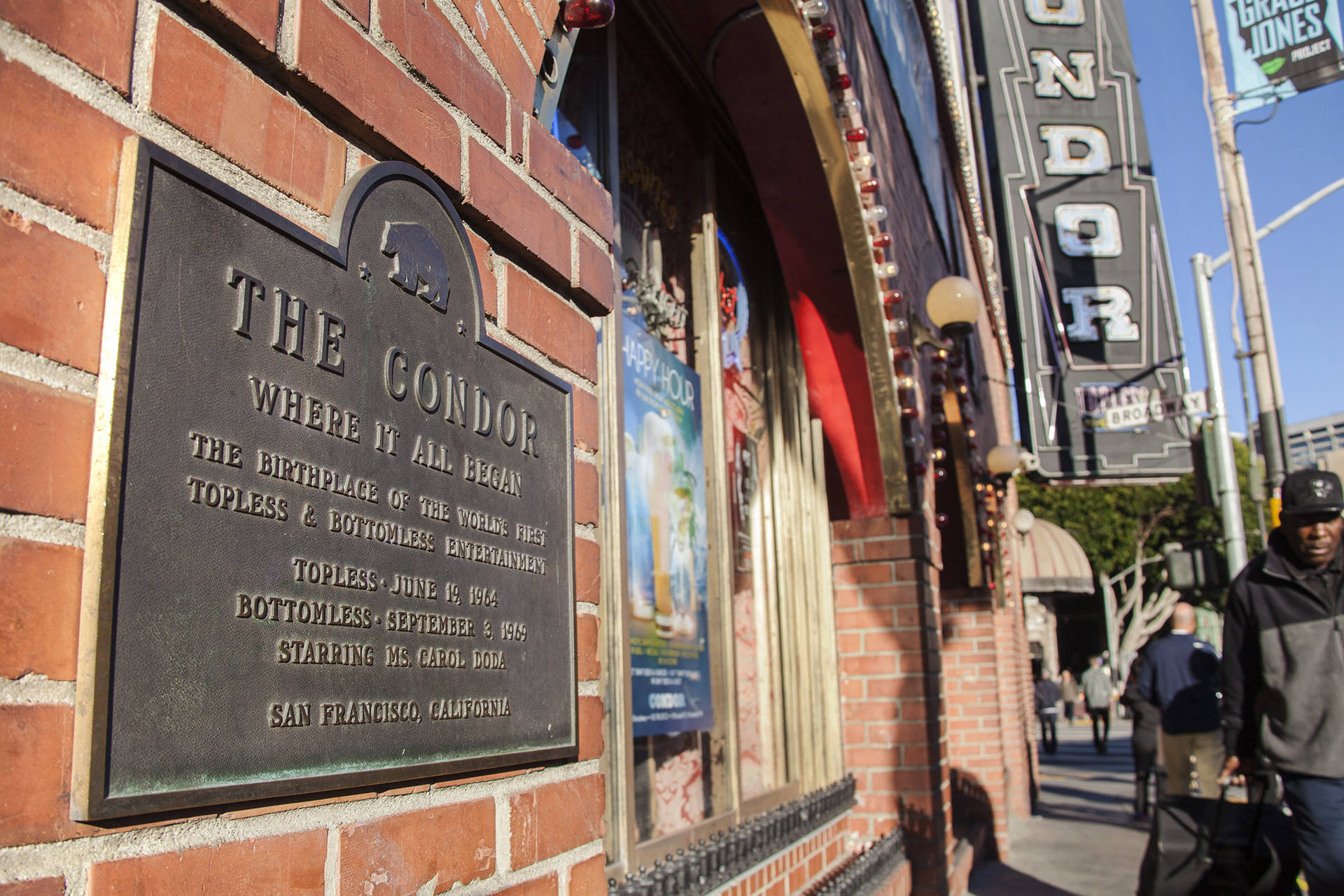
A plaque hangs outside the Condor Club in San Francisco's North Beach. (Brittany Hosea-Small/KQED)
Carol Doda Goes Topless For the First Time
In the 1960s, people watched dancers perform in pasties and swimsuits at go-go bars on Broadway in North Beach.
On June 19, 1964, at the Condor Club, a cocktail waitress named Carol Doda tossed aside her pasties and did The Swim dance in a topless monokini.
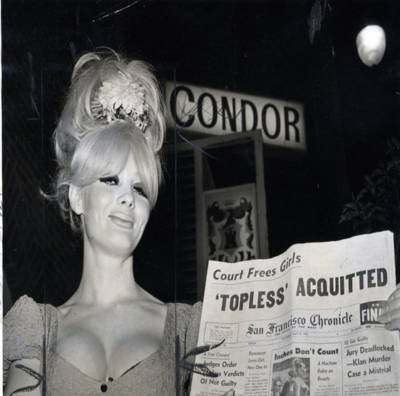
Carol Doda acquitted on indecency charge, 1965. (United Press International)
Doda, who's now deceased, said in a 1997 KRON-TV documentary that the audience was captivated.
“They were lined up around the corner. It’s like they had never seen bare breasts before in their lives," she said. Baring her nipples was a big deal, she added -- "the greatest thing since sliced bread."
Doda’s dance sparked a sexual revolution of its own. There was an explosion of adult bookstores, erotic massage parlors and porn theaters, particularly in the North Beach and Tenderloin neighborhoods.
Sides says San Francisco went from having no topless clubs in 1964 to having about 40 within a year.
“San Francisco became the sort of example that every city wanted to avoid,” he said.
The Smut Capital of America
In 1969, local and state lawmakers started to crack down on obscenity and indecency. Dianne Feinstein was running for the San Francisco Board of Supervisors that year, and she pointed to "the growth of obscenity” as one of the things ruining the city.
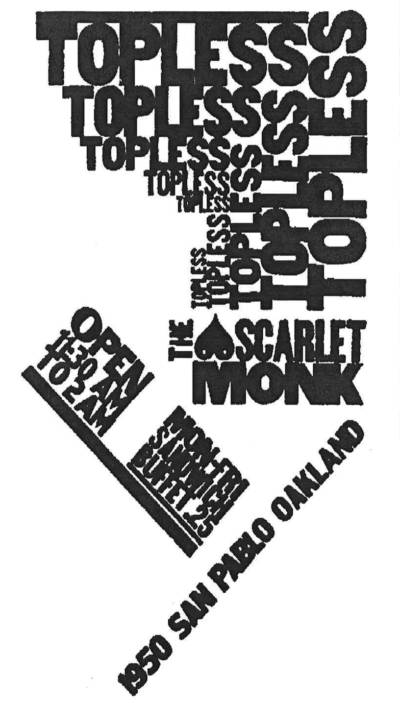
An ad for a topless bar in the Oakland Tribune during the topless and bottomless craze in 1969. (Oakland Public Library)
In September 1969, Gov. Ronald Reagan signed the Quimby-Walsh Act. The law allowed cities and counties to regulate how waiters, waitresses and entertainers dress in bars and restaurants.
On Jan. 22, 1970, Oakland passed an ordinance prohibiting “exposure of portions of the human body in specified places.” City officials had been waiting for Reagan to sign the Quimby-Walsh Act so they could stifle the topless -- and emerging bottomless -- craze.
To this day, that ordinance is what keeps strip clubs out of Oakland.
"We get quite a bit of interest of individuals wanting to start strip clubs in Oakland, but unfortunately the city’s policies and regulations don’t allow that at this time," says Juno Thomas, Small Business Assistance Center coordinator for the Oakland Economic and Workforce Development Department.
We Don't Want You Here!
The ban over all of Alameda County means there’s also no legal strip clubs in cities like Hayward, Emeryville or Berkeley.
Other cities in the East Bay use zoning rules to discourage strip clubs and restrict where they try to open. That’s how it’s done in Contra Costa County -- home to the cities of Richmond and Walnut Creek. In fact, zoning is the most common way municipalities deal with strip clubs.
As for McQueen, she’s hoping Oakland will change its rules to match San Francisco.
“I don’t feel like my dancers that live in Oakland need to go make their money in San Francisco," McQueen says. "I just feel like they need to be able to make their money where they live."
For now, she’ll just keep doing her thing -- pasties and G-strings -- in Oakland.
Child_Of_God
Vice City 2026
@Hater Motivator Don’t forget about Ryan Coogler.
JoseLuisGotcha
Aka Allhiphopsux
I give it a 10
Original culture
Birthplace of the panthers
Tupac got schooled out there
Pimp central
Etc etc
one if If not there most culturally significant cities today
Original culture
Birthplace of the panthers
Tupac got schooled out there
Pimp central
Etc etc
one if If not there most culturally significant cities today
Hater Eraser
Veteran
Hater Eraser
Veteran
Oakland is ADOS WAKANDA




Oakland is ADOS WAKANDA


and most of the leads in Black Panther have white girlfriends, white boyfriends or white wives/husbands.


Hater Eraser
Veteran
Spinning Rims, Spinning Cars: the History of the Oakland Sideshow

Spectators watch a sideshow at Foothill Boulevard and 55th Avenue in East Oakland on June 21, 2015. (Jay Area/YouTube)
Cars swerving back and forth, spinning in circles; the sound of tires screeching against concrete; the smell of burnt rubber. The cheers of those standing on the sidelines.
It’s not NASCAR. It’s not "The Fast and the Furious."
This is the sideshow. And it started in Oakland.
Bay Curious listener Shirley Yuen moved to Oakland six years ago and has seen sideshows only on the news.
“I had to do a Wikipedia search after the news just to see what this is about. Why are people taking their cars out and doing all these crazy stunts?" asks Shirley.
Now Shirley wants to know ...
“What's up with sideshows? Why are they in Oakland? And how did crime become associated with them?”
Sideshow Beginnings
The original sideshows were not dangerous or nefarious. They were pop-up parties -- part car show, part block party.
They first bubbled up in mall parking lots of Deep East Oakland in the 1980s, says Sean Kennedy, a multimedia producer and local hip-hop historian.
“It seems like it started when hip-hop first got out here,” Kennedy says.
I meet him at the entrance to the Foods Co in Foothill Square. It's so deep into East Oakland it is almost San Leandro. Kennedy says this is where it all began.
“There was a carnival that used to exist right here in Foothill Square, because there was a skating rink right here,” he says. “All the people would come down here to the skating rink and the carnival. They would bring their best cars and just cruise."
Kennedy says that what many people think of as a sideshow these days, all doughnuts and destruction, was not the way it began. Back then, “no one did doughnuts or spun their cars.” It was just peacocking, showing off the cars that were the pride and joy of many -- mostly male -- residents. “That,” Kennedy says, “was the original sideshow of East Oakland.”
People had cruised around in their souped-up Chevys before, but it was as if the introduction of the new music taught the cars to dance.
As sideshows spread, Kennedy says, they became a sort of cultural marketplace. People repped parties, hawked homemade fashion lines and shared the latest beats and music.
It was always firmly rooted in a sense of place, Kennedy says. "It's in the soil. For some reason the air here in East Oakland breeds that kind of creativity."
The Sideshow as Cultural Marketplace
Yakpasua Zazaboi documented sideshows across East Oakland for his documentary series "Sydewayz."
According to Zazaboi, sideshows were part craft fair, part improv performance, and always a place to catch the cultural zeitgeist. The sideshows, he says, were not just part of Oakland's unique hyphy culture: They formed the space in which hyphy was born.
“You would come out and you would really understand what is popular in Oakland,” Zazaboi says. A key part of that was the music. “I think for about three or four years straight, we used to hear this song by a group called 3X Krazy.”
“It was just a baseline and it was so popular and would sound so good on really nice audio systems, it was almost like a sideshow theme," Zazaboi says.
When asked to name his pick for the theme of the sideshows, Sean Kennedy says there is really only one: Richie Rich’s sideshow song.
“Now that's a classic when it comes to explaining the sideshow, in the early days,” says Kennedy.
You can hear the whole sideshow in Richie Rich’s deep and sonorous voice. “In Oakland, California," he raps, "every Saturday night brothers be riding, straight-laced zeniths, drop-tops, buckets, high performance.”
Music might have been the lifeblood of the sideshow but, according to Kennedy, the heart pumping that blood was the neighborhood's deep-rooted car culture.
Car Culture and the Sideshow
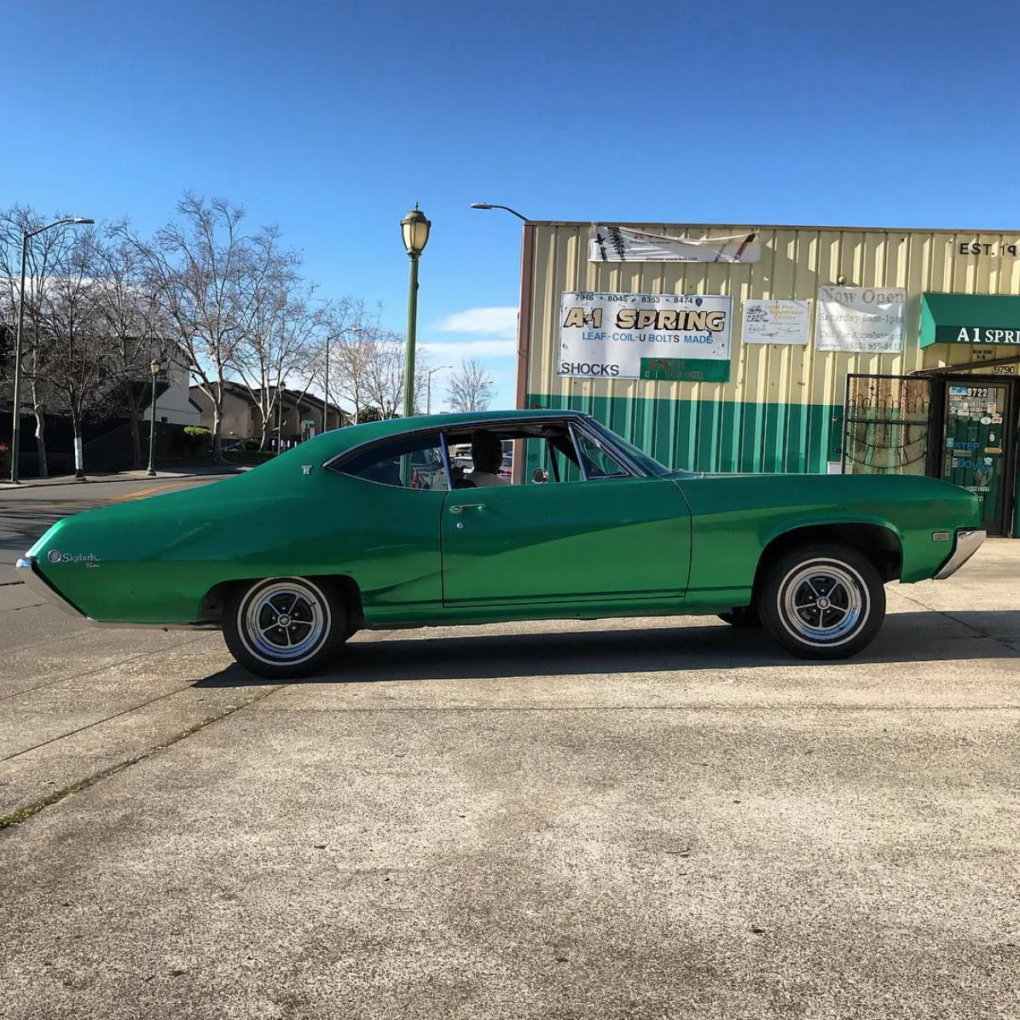
A car sitting outside A-1 Spring Service (@a1springservice/Instagram)
Ruben Flores greets a customer whose car he has just modified at A-1 Spring Service.
This was -- and still is -- the go-to place to bring your car for modifications.
Flores, who went to Castlemont, the neighborhood high school, got the job straight out of school.
“The owner of the shop, he was losing a man, a mechanic, so he came down to the high school to ask about the auto shop program,” Flores says. He was hired on the spot, and has been here ever since. Now he owns the place.
"The first day of work became the longest day of work, 38 years later,” Flores says, laughing as he shakes his head. Those years have given him a passenger seat to car culture in Deep East Oakland. He confirms what Sean Kennedy told me -- that in the beginning, it wasn’t about souping up cars to go fast.
“It was going lower,” Flores says. “Low and slow.” The best way to show off the beauty of your car.
Flores says his shop became known for fixing up cars in a signature style.
“What A-1 means, in the car culture, is the stance is higher in the front and lower in the back," Flores says. “So they have that pointing-towards-the-moon type of look.”
“That was the place to go,” he says. “People would say, I have my car sitting A-1.' It was because of the name of the shop.”
Over time the sideshows began to change. They went from low and slow to fast and loose, with drivers performing tricks with increasing levels of difficulty and danger. The Oakland Police Department began to take notice.
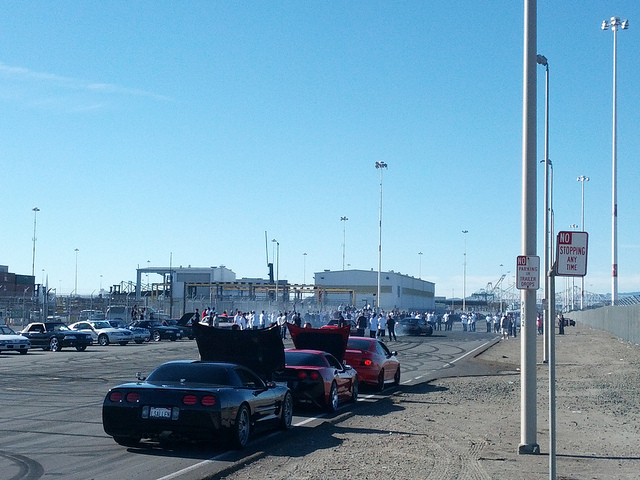
Sideshow at the Port of Oakland (Steve/Flickr)
Sideshows Run Into the Law
Everyone has a story about when and how things got out of hand. Zazaboi says it was when guys with cheap cars started doing doughnuts to get attention.
Sean Kennedy says it was when the new built-for-speed Mustangs came on the market in the 1980s.
Maybe it was the death of a young girl during a police chase after a sideshow got busted in the mid-'90s.
Whatever the exact moment, the crackdown by Oakland police and the city were swift. New laws were introduced that criminalized sideshow spectators, you could be fined, even arrested, for just watching. Then came a 2005 ordinance, which allowed police to permanently confiscate any car directly involved in a sideshow. According to Zazaboi, that made it personal.
“Their car is an extension of their ego,” Zazaboi says of sideshow participants. “You take away their car, you kill their ego, and that is exactly what they did out here in Oakland.”
Sean Kennedy says that response complicated the already tense relationship between police and the community.
"Does that create an animosity to the police?" Kennedy asks. "It becomes a war at that point. And then it becomes a situation where the rebellion is, 'We're going to have sideshows anyway.' "
Both Kennedy and Zazaboi say that while local politicians criminalized the sideshow, local media demonized it, with story after story of violent, out-of-control youth taking over the streets.
Kennedy admits that bad stuff did go down, and there was by necessity a kind of nomadic, extra-legal element to the sideshows. People brought guns and sold drugs; sometimes fights broke out. And yes, young men acted stupid. But he says all that was just as likely to happen at a Raiders game.
Kennedy says despite all that, the sideshow did not breed criminal behavior.
"It's not about a car show," he says. "At that point, it's about arresting black youth in Oakland."
He says the sideshow made it easy to paint East Oakland youth into an already-made stereotype: "Young black kids who don’t have anything to do with their lives, out there playing around in these cars, carrying guns and selling drugs.”
Celebrating the Sideshow
What was lost in that narrative, Kennedy says, was the ingenuity of the sideshow: the mechanical skills it took to work on the cars, the driving skills it took to get them moving and dancing, the coordination to plan what are in essence the Bay Area's first pop-up events. Long before pop-up events was even a term.
Kennedy acknowledges his perspective has changed with age. Now that he has a few years on him, he is a little more weary of making cars spin like whirling dervishes.
"As much as I love sideshows," he says, "it’s a dangerous culture when it comes to spinning around a half-a-ton vehicle with no barriers and people standing there."
That is why Kennedy, among others, supported a push to legalize sideshows that gained some ground in the late 2000s. The suggestion was to bring sideshows out of the shadows and turn them into neighborhood street parties. They could even make money, proponents argued.
But opponents, like City Councilman Larry Reid, who represents Deep East Oakland, countered that it was folly for the city to sanction an illegal activity.
Reid says the sideshows slowed down for a bit, but they seem to have picked up once again.
If you ask Yakpasua Zazaboi, he will say what is happening now is not even a real sideshow.
"I break it down like this now," Zazaboi says. "This is how you know it's a sideshow. If there are clean cars and women out there, you might have a sideshow. If it's a bunch of buckets and a whole bunch of dudes clowning around looking at each other -- you do not have sideshow."
The definition of just what makes a sideshow is constantly in flux. Every generation has its own version, just like every sideshow has people who say it is either a criminal act or a space for the creation of culture. Maybe, just maybe, there is a little bit of both, hanging out at the sideshow.
Biscayne
Ocean air
Yes....

Oakland gets a 10 off the strength of those two groups.
Spinning Rims, Spinning Cars: the History of the Oakland Sideshow

Spectators watch a sideshow at Foothill Boulevard and 55th Avenue in East Oakland on June 21, 2015. (Jay Area/YouTube)
Cars swerving back and forth, spinning in circles; the sound of tires screeching against concrete; the smell of burnt rubber. The cheers of those standing on the sidelines.
It’s not NASCAR. It’s not "The Fast and the Furious."
This is the sideshow. And it started in Oakland.
Bay Curious listener Shirley Yuen moved to Oakland six years ago and has seen sideshows only on the news.
“I had to do a Wikipedia search after the news just to see what this is about. Why are people taking their cars out and doing all these crazy stunts?" asks Shirley.
Now Shirley wants to know ...
“What's up with sideshows? Why are they in Oakland? And how did crime become associated with them?”
Sideshow Beginnings
The original sideshows were not dangerous or nefarious. They were pop-up parties -- part car show, part block party.
They first bubbled up in mall parking lots of Deep East Oakland in the 1980s, says Sean Kennedy, a multimedia producer and local hip-hop historian.
“It seems like it started when hip-hop first got out here,” Kennedy says.
I meet him at the entrance to the Foods Co in Foothill Square. It's so deep into East Oakland it is almost San Leandro. Kennedy says this is where it all began.
“There was a carnival that used to exist right here in Foothill Square, because there was a skating rink right here,” he says. “All the people would come down here to the skating rink and the carnival. They would bring their best cars and just cruise."
Kennedy says that what many people think of as a sideshow these days, all doughnuts and destruction, was not the way it began. Back then, “no one did doughnuts or spun their cars.” It was just peacocking, showing off the cars that were the pride and joy of many -- mostly male -- residents. “That,” Kennedy says, “was the original sideshow of East Oakland.”
People had cruised around in their souped-up Chevys before, but it was as if the introduction of the new music taught the cars to dance.
As sideshows spread, Kennedy says, they became a sort of cultural marketplace. People repped parties, hawked homemade fashion lines and shared the latest beats and music.
It was always firmly rooted in a sense of place, Kennedy says. "It's in the soil. For some reason the air here in East Oakland breeds that kind of creativity."
The Sideshow as Cultural Marketplace
Yakpasua Zazaboi documented sideshows across East Oakland for his documentary series "Sydewayz."
According to Zazaboi, sideshows were part craft fair, part improv performance, and always a place to catch the cultural zeitgeist. The sideshows, he says, were not just part of Oakland's unique hyphy culture: They formed the space in which hyphy was born.
“You would come out and you would really understand what is popular in Oakland,” Zazaboi says. A key part of that was the music. “I think for about three or four years straight, we used to hear this song by a group called 3X Krazy.”
.


Sankofa Alwayz
#FBADOS #B1 #D(M)V #KnowThyself #WaveGod
9/10 for me.
Always wanted to visit The Town, even more so than SF itself.
Very diverse city but carries itself like the legacy Black Mecca that it was/is. Quite possibly the most culturally unique city in the whole West Coast and is responsible for blessing Da Culture with the Black Panther Party, Killmonger’s backstory, ‘93 Til Infinity, Digital Underground/2Pac’s West Coast career jumpstart, Too $hort, Mackin’, a fukk the police mentality before NWA’s fukk The Police even dropped, MC Hammer, Tony Toni Tone, En Vogue, Side-showing, etc.
Architecturally an eclectic mesh between East Coast and West Coast. A very gritty city with a chill and artsy vibe judging from the people and the amount of street art there, seems more legitimately counter-cultural than San Fran these days. Also very distinct from SF even with gentrification creeping out of the downtown Oakland area. Comes off as a neighborhood city like Baltimore and Philly. Very anti-pretentious place.
Heard Oakland’s food scene is cheaper and even better than SF’s in some aspects. I’m willing to bet I can find some really good ass Mexican, Soul Food, Ethiopian/Eritrean, Chinese, Vegetarian/Vegan, Japanese, Laotian, Jamaican, Thai, Indian, Middle Eastern, Vietnamese, Pakistani, Taiwanese, Malaysian, Ghanaian, Senegalese, Nigerian, etc.
Nightlife is most likely better than SF’s and more interesting. Oakland also seems like a West Coast version of ATL where it seems like it’s always some fun shyt to get into every day of the week, especially when it comes to street festivals.
The women seem fine asf.
I fux with that Town slang and accent.
And it seems like housing is cheap relative to the rest of the Bay Area.
Only strikes against it are some of the racist antics of Oakland PD (hell just watching Fruitvale Station had me HEATED at the end) and the propensity for some of the non-Blacks out there to say nikka as if that shyt’s second nature to them
Other than that, I fux with The Town.
Always wanted to visit The Town, even more so than SF itself.
Very diverse city but carries itself like the legacy Black Mecca that it was/is. Quite possibly the most culturally unique city in the whole West Coast and is responsible for blessing Da Culture with the Black Panther Party, Killmonger’s backstory, ‘93 Til Infinity, Digital Underground/2Pac’s West Coast career jumpstart, Too $hort, Mackin’, a fukk the police mentality before NWA’s fukk The Police even dropped, MC Hammer, Tony Toni Tone, En Vogue, Side-showing, etc.
Architecturally an eclectic mesh between East Coast and West Coast. A very gritty city with a chill and artsy vibe judging from the people and the amount of street art there, seems more legitimately counter-cultural than San Fran these days. Also very distinct from SF even with gentrification creeping out of the downtown Oakland area. Comes off as a neighborhood city like Baltimore and Philly. Very anti-pretentious place.
Heard Oakland’s food scene is cheaper and even better than SF’s in some aspects. I’m willing to bet I can find some really good ass Mexican, Soul Food, Ethiopian/Eritrean, Chinese, Vegetarian/Vegan, Japanese, Laotian, Jamaican, Thai, Indian, Middle Eastern, Vietnamese, Pakistani, Taiwanese, Malaysian, Ghanaian, Senegalese, Nigerian, etc.
Nightlife is most likely better than SF’s and more interesting. Oakland also seems like a West Coast version of ATL where it seems like it’s always some fun shyt to get into every day of the week, especially when it comes to street festivals.
The women seem fine asf.
I fux with that Town slang and accent.
And it seems like housing is cheap relative to the rest of the Bay Area.
Only strikes against it are some of the racist antics of Oakland PD (hell just watching Fruitvale Station had me HEATED at the end) and the propensity for some of the non-Blacks out there to say nikka as if that shyt’s second nature to them

Other than that, I fux with The Town.
Last edited:


